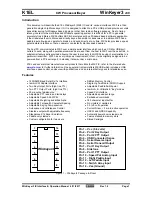
5-204
N60 NETWORK STABILITY AND SYNCHROPHASOR MEASUREMENT SYSTEM – INSTRUCTION MANUAL
FLEXLOGIC
CHAPTER 5: SETTINGS
5
Figure 5-107: FlexElement logic
FLEXELEMENT 1 +IN
— This setting specifies the first (non-inverted) input to the FlexElement. Zero is assumed as the input if
this setting is set to “Off.” For proper operation of the element, at least one input must be selected. Otherwise, the element
does not assert its output operands.
FLEXELEMENT 1 –IN
— Specifies the second (inverted) input to the FlexElement. Zero is assumed as the input if this setting is
set to “Off.” For proper operation of the element, at least one input must be selected. Otherwise, the element does not
assert its output operands. This input is used to invert the signal if needed for convenience, or to make the element
respond to a differential signal, such as for a top-bottom oil temperature differential alarm. The element does not operate
if the two input signals are of different types, for example if one tries to use active power and phase angle to build the
effective operating signal.
The element responds directly to the differential signal if the
FLEXELEMENT 1 INPUT MODE
setting is set to “Signed” The
element responds to the absolute value of the differential signal if this setting is set to “Absolute.” Sample applications for
the “Absolute” setting include monitoring the angular difference between two phasors with a symmetrical limit angle in
both directions, monitoring power regardless of its direction, or monitoring a trend.
The element responds directly to its operating signal—as defined by the
FLEXELEMENT 1 +IN
,
FLEXELEMENT 1 –IN
and
FLEXELEMENT 1 INPUT MODE
settings—if the
FLEXELEMENT 1 COMP MODE
setting is set to “Level.” The element responds to the
rate of change of its operating signal if the
FLEXELEMENT 1 COMP MODE
setting is set to “Delta.” In this case, the
FLEXELEMENT 1 dt UNIT
and
FLEXELEMENT 1 dt
settings specify how the rate of change is derived.
FLEXELEMENT 1 DIRECTION
— Enables the relay to respond to either high or low values of the operating signal. The following
figure explains the application of the
FLEXELEMENT 1 DIRECTION
,
FLEXELEMENT 1 PICKUP
, and
FLEXELEMENT 1 HYSTERESIS
settings.
















































